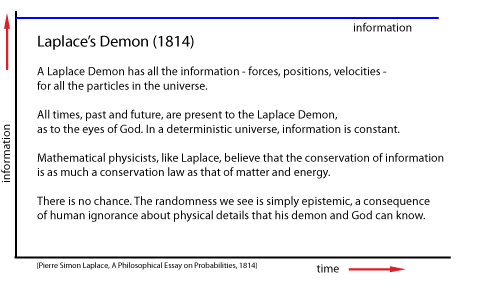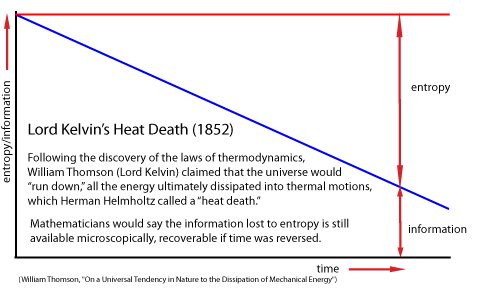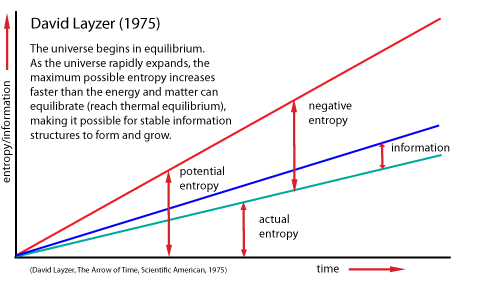In the introduction to his 1814
Essai philosophique sur les probabilités, Pierre-Simon Laplace extended an idea of
Gottfried Leibniz which became famous as Laplace's Demon, the
locus classicus definition of strict physical determinism, with its one possible future.
Laplace said,
"We may regard the present state of the universe as the effect of its past and the cause of its future. An intellect which at a certain moment would know all forces that set nature in motion, and all positions of all items of which nature is composed, if this intellect were also vast enough to submit these data to analysis, it would embrace in a single formula the movements of the greatest bodies of the universe and those of the tiniest atom; for such an intellect nothing would be uncertain and the future just like the past would be present before its eyes."
Laplace postulates a super-intelligence that could know the positions, velocities, and forces on all the particles in the universe at one time, and thus know the universe for all times. The concept has been criticized for the vast amount of information that would be required, impractical if not impossible to collect instantaneously. And where would the information be kept? If in some part of the universe, there would be an infinite regress of information storage.
If we imagine the exercise as purely mental, involving only the idea of such knowledge, we can see the Laplace's demon as a secular substitute for an omniscient God with perfect foreknowledge.
Laplace's view implies that the past and the present always contain exactly the same knowledge. This makes information a constant of nature. Indeed, some mathematicians think that information is a conserved quantity (the blue line in the figure), like the conservation of mass and energy.

However, midway through the 19th century,
Lord Kelvin (William Thomson) realized that the newly discovered second law of thermodynamics required that information could not be constant, but would be destroyed as the entropy (disorder) irreversibly increased. Hermann Helmholtz described this as the heat death of the universe.
Physicists, including
Ludwig Boltzmann, described entropy as "lost information," although many mathematicians thought the lost information might be recoverable (for example, by reversing the time).

Kelvin’s claim would be correct if the universe were a closed system. But in our open and expanding universe, David Layzer showed that the maximum possible entropy is increasing faster than the actual entropy. The difference between maximum possible entropy and the current entropy is called negative entropy, opening the possibility for complex and stable information structures.

The current view of the universe is a "heat birth" and a "cold death."
So we now know that a Laplace Demon is impossible, and for two distinct reasons. The old reason was that modern quantum physics is inherently indeterministic. The future is only probabilistic, though it may be "adequately determined."
The new reason is that there is not enough information in the past (none at all in the early universe) to determine the present.
The "fixed past" and the "laws of nature" pre-determine nothing, despite recent philosophical arguments.
Similarly, information at the present time does not determine the future. The future is open. We must create it.
It follows that
determinism, the philosophical idea that every event or state of affairs, including every human decision and action, is the inevitable and
necessary consequence of antecedent states of affairs, is not true.
More precisely, determinism, or
determination by some preceding events as causes, should be distinguished from the
pre-determinism of Laplace's time, the idea that the entire past (as well as the future) was determined at the origin of the universe.
 However, midway through the 19th century, Lord Kelvin (William Thomson) realized that the newly discovered second law of thermodynamics required that information could not be constant, but would be destroyed as the entropy (disorder) irreversibly increased. Hermann Helmholtz described this as the heat death of the universe.
Physicists, including Ludwig Boltzmann, described entropy as "lost information," although many mathematicians thought the lost information might be recoverable (for example, by reversing the time).
However, midway through the 19th century, Lord Kelvin (William Thomson) realized that the newly discovered second law of thermodynamics required that information could not be constant, but would be destroyed as the entropy (disorder) irreversibly increased. Hermann Helmholtz described this as the heat death of the universe.
Physicists, including Ludwig Boltzmann, described entropy as "lost information," although many mathematicians thought the lost information might be recoverable (for example, by reversing the time).
 Kelvin’s claim would be correct if the universe were a closed system. But in our open and expanding universe, David Layzer showed that the maximum possible entropy is increasing faster than the actual entropy. The difference between maximum possible entropy and the current entropy is called negative entropy, opening the possibility for complex and stable information structures.
Kelvin’s claim would be correct if the universe were a closed system. But in our open and expanding universe, David Layzer showed that the maximum possible entropy is increasing faster than the actual entropy. The difference between maximum possible entropy and the current entropy is called negative entropy, opening the possibility for complex and stable information structures.
 The current view of the universe is a "heat birth" and a "cold death."
So we now know that a Laplace Demon is impossible, and for two distinct reasons. The old reason was that modern quantum physics is inherently indeterministic. The future is only probabilistic, though it may be "adequately determined."
The new reason is that there is not enough information in the past (none at all in the early universe) to determine the present.
The "fixed past" and the "laws of nature" pre-determine nothing, despite recent philosophical arguments.
Similarly, information at the present time does not determine the future. The future is open. We must create it.
It follows that determinism, the philosophical idea that every event or state of affairs, including every human decision and action, is the inevitable and necessary consequence of antecedent states of affairs, is not true.
More precisely, determinism, or determination by some preceding events as causes, should be distinguished from the pre-determinism of Laplace's time, the idea that the entire past (as well as the future) was determined at the origin of the universe.
The current view of the universe is a "heat birth" and a "cold death."
So we now know that a Laplace Demon is impossible, and for two distinct reasons. The old reason was that modern quantum physics is inherently indeterministic. The future is only probabilistic, though it may be "adequately determined."
The new reason is that there is not enough information in the past (none at all in the early universe) to determine the present.
The "fixed past" and the "laws of nature" pre-determine nothing, despite recent philosophical arguments.
Similarly, information at the present time does not determine the future. The future is open. We must create it.
It follows that determinism, the philosophical idea that every event or state of affairs, including every human decision and action, is the inevitable and necessary consequence of antecedent states of affairs, is not true.
More precisely, determinism, or determination by some preceding events as causes, should be distinguished from the pre-determinism of Laplace's time, the idea that the entire past (as well as the future) was determined at the origin of the universe.

